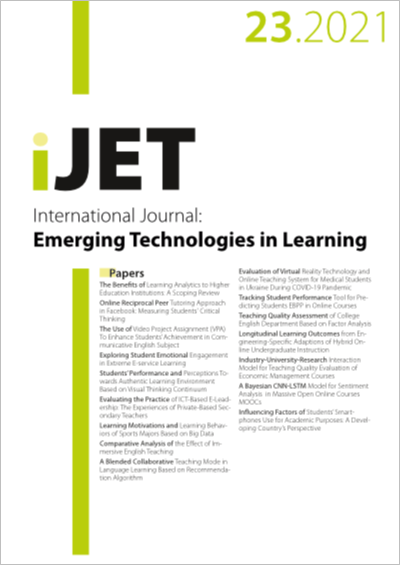Virtual Workspaces for Enhancing Collaborative Work in EFL Learning: A Case Study in Higher Education
DOI:
https://doi.org/10.3991/ijet.v17i02.25937Keywords:
Virtual workspaces, EFL learning, Jamboard, collaborative workAbstract
Abstract— The purpose of this study was to determine students’ perceptions towards the use of virtual workspaces for enhancing collaborative work in higher education. The participants were 122 (72 graduate and 50 postgraduate) Teaching English as a foreign language (TEFL) students who were enrolled in different courses at a private university in Ecuador. The students’ proficiency levels varied from B1 to C1 according to the Common European Framework of Reference for Languages (CEFR). A mixed-method approach was used comprising qualitative and quantitative methods; thus, a diagnostic questionnaire, a perceptions ques-tionnaire, a semi-structured interview, and observation checklists were adminis-tered as instruments. This research involved an online instructional process in which teachers implemented virtual workspaces using Jamboard as a tool to de-sign collaborative activities. The results evidenced that the use of virtual work-spaces helped students develop their collaborative skills and promoted their open-mindedness. Also, virtual workspaces allow teachers to build positive e-learning environments in which students can discuss topics from different perspectives and show respect for each other’s ideas.
Downloads
Published
2022-01-31
How to Cite
Castillo-Cuesta, L., Ochoa-Cueva, C., & Cabrera-Solano, P. (2022). Virtual Workspaces for Enhancing Collaborative Work in EFL Learning: A Case Study in Higher Education. International Journal of Emerging Technologies in Learning (iJET), 17(02), pp. 4–18. https://doi.org/10.3991/ijet.v17i02.25937
Issue
Section
Papers
License
Copyright (c) 2021 Luz Castillo-Cuesta, Cesar Ochoa-Cueva, Paola Cabrera-Solano

This work is licensed under a Creative Commons Attribution 4.0 International License.



